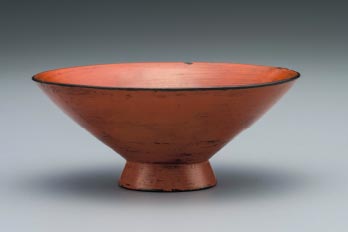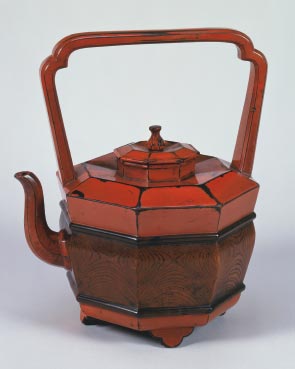|
|
|
|
D. 12.2 cm
Private Collection (formerly owned by Masako Shirasu) |
 |
|
The linear appearance of this cup gives a new sense of
medieval negoro, though one look inside the vessel reveals
an antique aesthetic through its gentle, deep interior. The
other appeal of this object is its lacquered finish, which
resembles melted glaze over ceramic ware. This distinctive
effect, unique to negoro, was created using a sticky coat of
red lacquer, which appears as if to show the traces of the
brush marks used to apply the lacquer. The literary figure
Masako Shirasu treasured this cup, which perhaps gives us a
glimpse of the aesthetic sensibility of one who beautifully
incorporated ancient objects in a modern setting. |
|
|
|
|
|
D. 30.5 cm (at widest point), H.
35.7 cm
Private collection
Hot water ewers, made of metal were originally used as
utensils for tencha tea ceremony, though many early
negoro
examples such as this can also be seen. Both practical
considerations, such as the depression at the top of this
ewer to prevent hot water from running down the sides and
the feet to keep the bottom from corroding, as well as the
ewer’s octagonal shape with all sides curved exhibits the
artisan’s exceptional artistic sensibility and technique.
The division of the red and black lacquer and the expression
of the wooden grain of the body also demonstrate the
appreciation for wood in Japan since the Jōmon period (ca.
10,500 BC–300 BC). Additionally, the contours created by the
exposure of the black lacquer along the ridgelines of the
octagonal body after long years of use contribute to a
quality unique to negoro. As with this ewer, the allure of
negoro can perhaps be attributed to the refinement and
development of the functionality and utility of an aesthetic
form and a style of lacquerware, in which the utmost nature
of wood was drawn out and, over long years, given flavor.
(*Works will be rotated during the exhibition.)
|
 |
 |
 |
 |